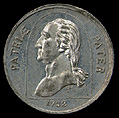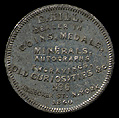Washington Storecard Tokens 1859-63: New York Continued
New York City - Continued
obverse |
|
reverse |
| |||
Baker 537 Fuld CWT 630AD-1a H.D. Gerdts 1863 [New York City]
Obverse: THE WASHINGTON TOKEN. 1863
Reverse: H.D. GERDTS. / BROKER / - & - / COIN DEALER / - 240 - / GREENWICH ST. N.Y.
Copper Weight: 54.3 g (3.51 grams) Diameter: 19.6 mm Reverse die alignment: 340°
Comments: The obverse shows an undraped bust right Washington, called THE WASHINGTON TOKEN. This obverse is cataloged by Fuld as Civil War reverse die 1137, which was also used on the storecard of J.L. Agens & Co. of Newark, New Jersey (Baker 508). The Gerdts token was issued in silver, copper, brass, nickel, copper-nickel and white metal.
Provenance: Part of an anonymous donation consisting of 1100 tokens and medals covering the Nineteenth century, primarily up through the Civil War era.
Reference: Rulau and Fuld, p. 264; Fuld, U.S. Civil War Store Cards, 2nd ed., p. 253.
obverse |
|
reverse |
| |||
Baker 542C Miller NY 308 E. Hill [ca. 1860] [G.H. Lovett] [New York City]
Obverse: PATRIÆ PATER [in exergue] 1732. [KEY under truncated shoulder]
Reverse: E. HILL, / DEAlER IN / COINS, MEDALS, / MINERALS, / AUTOGRAPHS / ENGRAVINGS, / OLD CURIOSITIES & C / N O. 6 / BLEECKER ST. N. YORK / 1860
White metal Weight: 113.6 g (7.36 grams) Diameter: 28.0 mm Reverse die alignment: 340°
Comments: The obverse was struck using the F.C. Key die depicting an undraped bust left of Washington within an arched frame. The Latin on the obverse, which is the opposite of the usual word order, translates as Father of the Country, while the date 1732, in exergue, is the year Washington was born. Note there is a die crack that travels from the bottom rim at about 7:00 o'clock up through Washington's throat, jawbone and hair to the rim at about 1:00 o'clock. This is related to a group of muled Washington tokens and medals (Baker 211, 337 and 633-636) made ca. 1860 by the New York City diemaker George H. Lovett using the Washington die of F.C. Key of Philadelphia. See the Washington muled token section for further details. Hill also muled other of the Lovett dies with his storecard including: Daniel Webster (Miller NY 309-312), Edwin Forrest (Miller NY 313-316), the smoker (Miller NY 317-320), cupid (Miller NY 321-324), the 320 Arch Street Key storecard (Miller NY 325-328) , the KEY storecard (Miller NY 329-332), the Woodgate storecard (Miller NY 333-336) and the Washington Key obverse with a VIRTUE, LIBERTY & INDEPENDENCE reverse (Miller NY 337-340). Also see the Woodgate storecard (Baker 593C) on the following page.
Provenance: Part of an anonymous donation consisting of 1100 tokens and medals covering the Nineteenth century, primarily up through the Civil War era.
References: Rulau and Fuld, p. 264; Rulau, Standard Catalog of United States Tokens, 2nd ed., pp. 241-242.
obverse |
|
reverse |
| |||
Baker 543 Fuld CWT 630AL-3a George Hyenlein Emil Sigel New York City
Obverse: [In small letters below the star] E SIGEL 177 WILLI / NY
Reverse: GEORGE HYENLEIN / * / 23 / CHRISTIE S T.. / N.Y.
Copper Weight: 52.4 g (3.39 grams) Diameter: 19.3 mm Reverse die alignment: 180°
Comments: The obverse of this token displays a small undraped bust right of Washington framed within a beaded oval that is the center of a five pointed star. The points of the star appear to be attached to a circular wreath. The name and address of the diecutter is added below the star. Click here to view a detail. Emil Sigel was located at 177 William Street in New York City during the Civil War period. This token was only produced in copper. This Washington obverse is cataloged by Fuld as Civil War reverse die 1132, and was also used on the undated storecard for H.M. Lane of New York City (Baker 554). It is also listed as Fuld Patriotic die 105 where is is found in at least ten different combinations. Probably both the Lane and Hyenlein storcards, as well as the patriotic tokens, were produced in 1863 (the year most of the Civil War storecards were produced in response to the government's withdrawal of metallic currency during 1862).
Provenance: Part of an anonymous donation consisting of 1100 tokens and medals covering the Nineteenth century, primarily up through the Civil War era.
References: Rulau and Fuld, p. 264; Fuld, U.S. Civil War Store Cards, 2nd ed., p. 256.
obverse |
|
reverse |
| |||
Baker 554 Fuld CWT 630AP-5a H.M. Lane Emil Sigel New York City
Obverse: [In small letters below the star] E SIGEL 177 WILLI / NY
Reverse: H.M. LANE / LAMPS / KEROSENE OIL & c / 18 / SPRING ST.. N.Y.
Copper Weight: 50.6 g (3.28 grams) Diameter: 19.4 mm Reverse die alignment: 180°
Comments: The obverse of this token displays a small undraped bust right of Washington framed within a beaded oval that is the center of a five pointed star. The points of the star appear to be attached to a circular wreath. The name and address of the diecutter is added below the star. Emil Sigel was located at 177 William Street in New York City during the Civil War period. The token was produced in copper, brass, nickel, copper-nickel, German silver and white metal. This Washington obverse is cataloged by Fuld as Civil War reverse die 1132, and was also used on the undated storecard for George Hyenlein of New York City (Baker 543). It is also listed as Fuld Patriotic die 105 where is is found in at least ten different combinations. Probably both the Lane and Hyenlein storcards were produced in 1863 (the year most of the Civil War storecards were produced in response to the government's withdrawal of metallic currency during 1862).
Provenance: Part of an anonymous donation consisting of 1100 tokens and medals covering the Nineteenth century, primarily up through the Civil War era.
References: Rulau and Fuld, p. 264; Fuld, U.S. Civil War Store Cards, 2nd ed., p. 258.
| StorecardsNY1 | Section Contents | StorecardsNY3 |







